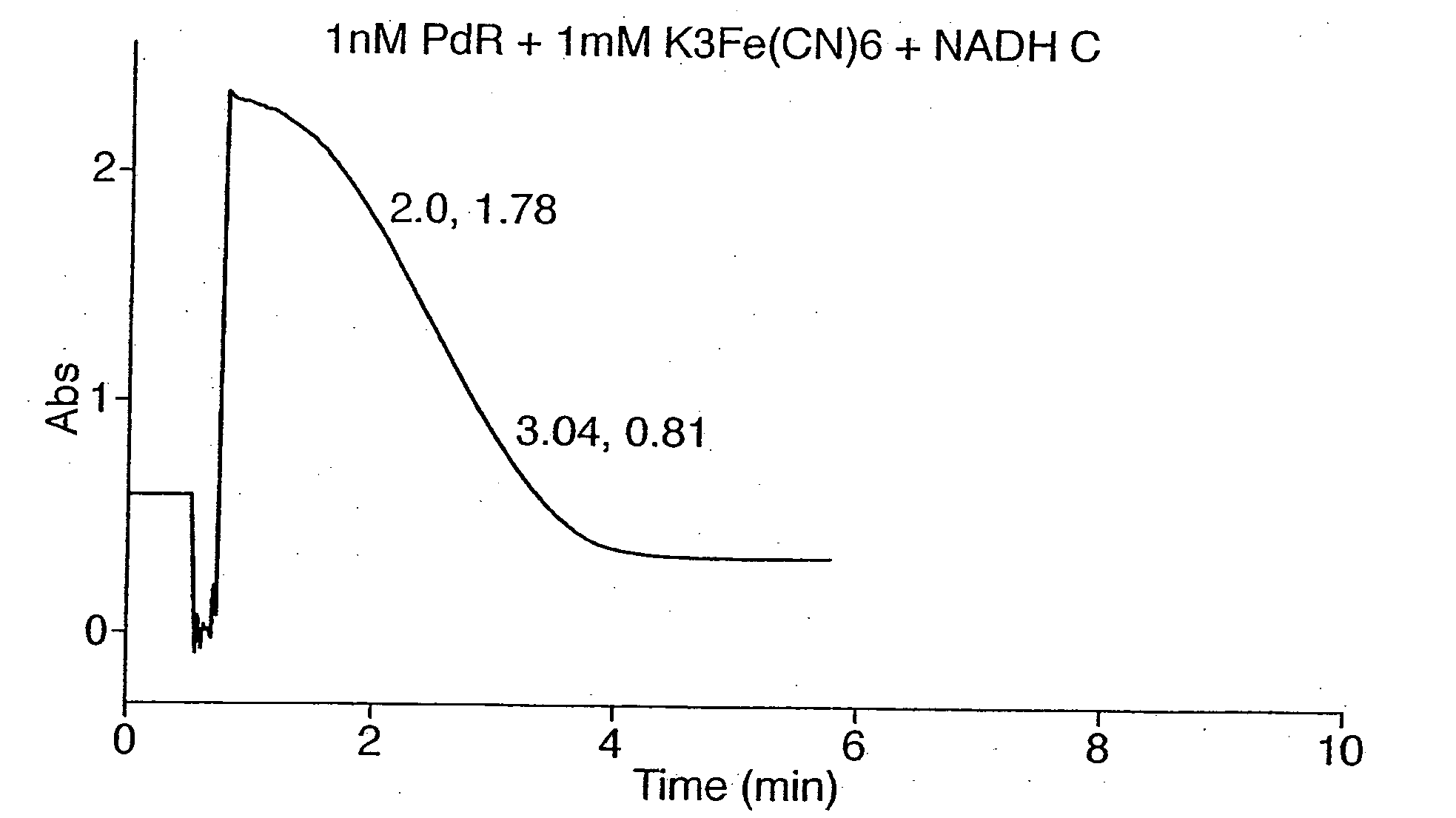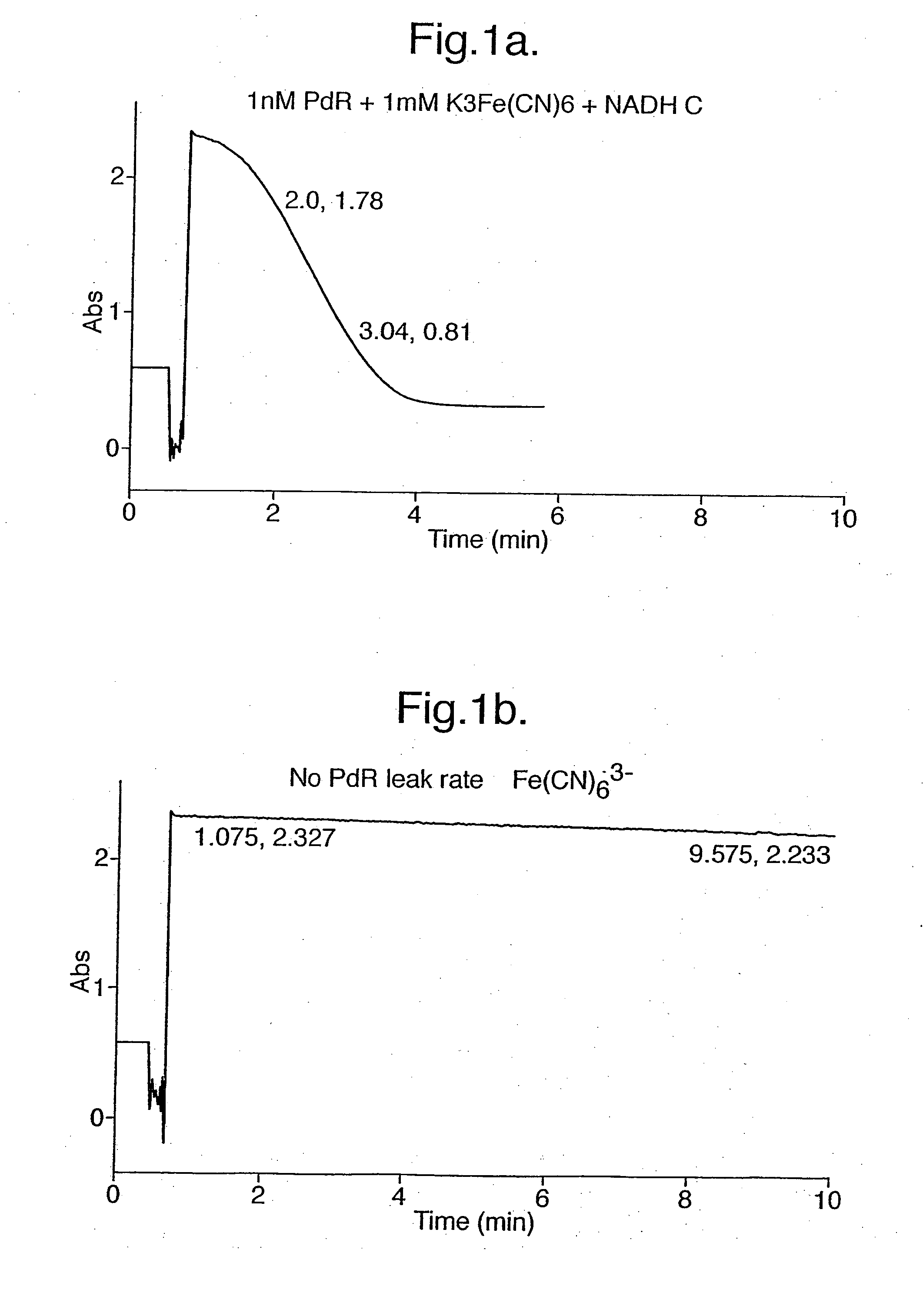Electrochemical detection of nadh or naph
a technology of nadh or naph and electrochemical detection, which is applied in the field of assays, can solve the problems of extra processing steps, cumbersome spectrophotometric assays, and difficulty in detecting nadh or naph, and achieves the effects of reducing the cost, reducing the cost, and speeding up the electron transfer ra
- Summary
- Abstract
- Description
- Claims
- Application Information
AI Technical Summary
Benefits of technology
Problems solved by technology
Method used
Image
Examples
example 1
Spectrophotometic Analysis for Putidaredoxin Reductase
Putidaredoxin reductase is specific to NADH. The oxidation of NADH by Fe(CN)63− catalysed by putidaredoxin reductase was demonstrated by a spectrophotometric assay.
1.5 ml of an incubation mixture containing 50 mM phosphate buffer, pH 7.4, 0.1 nM putidaredoxin reductase, and 1 mM K3Fe(CN)6 was added to cuvettes. A spectrophotometer was used to measure the absorbance at 340 nm and set to zero using a cuvette containing the incubation mixture alone.
NADH was then added to some of the cuvettes containing the incubation mixture as a 30 mM stock in 50 mM phosphate buffer, pH 7.4 to a final concentration of 300 μM (A340 nm ca, 1.8) and absorbance at 340 nm monitored. As shown by FIG. 1a, the absorbance due to NADH decreased steadily with time as it was oxidised to NAD+ by ferricyanide acting as an oxidising agent in a reaction mediated by putidaredoxin reductase which catalysed the transfer of electrons from one to the other. If ei...
example 2
Spectrophotometric Analysis for the P450BM-3 Falvin Domain
The flavin domain of P450BM-3 is specific for NADPH. The oxidation of NADPH by both Fe(CN)63− and Ru(NH3)3+ catalysed by the flavin domain of P450BM-3 was demonstrated by spectrophotometric assays.
1.5 ml of an incubation mixture containing 50 mM phosphate buffer, pH 7.4, 50 nM of the flavin domain of P450BM-3, and either 1 mM K3Fe(CN)6or 2 mM Ru(NH3)63+ was added to cuvettes. A spectrophotometer was used to measure the absorbance changes at the relevant wavelength.
For the ferricyanide reduction assay, the reaction was monitored at the 420 nm absorptions of ferricyanide. NADPH was added to the sample cuvette as a 30 mM stock in 50 mM phosphate, pH 7.4 to a final concentration of ca. 500 μM (A340 nm=3.0) and the absorbance at 420 nm monitored. As shown in FIG. 2, all the ferricyanide was reduced to the ferrocyanide in less than 80 seconds.
For the Ru(NH3)63+ reduction assay, the reaction was monitored at the NADPH absorp...
example 3
Spectrophotometric Analysis for Spinach Ferredoxin Reductase
Spinach ferredoxin reductase is specific for NADPH. The oxidation of NADPH by both Fe(CN)63− and Ru(NH3)63+ catalysed by spinach ferredoxin reductase was demonstrated by spectrophotometric assays.
1.5 ml of an incubation mixture containing 50 mM phosphate buffer, pH 7.4, 0.05 units of spinach ferredoxin reductase, and either 1 mM K3Fe(CN)6 or 2 mM Ru(NH3)63+ was added to cuvettes. A spectrophotometer was used to measure the absorbance changes at the relevant wavelength.
For the ferricyanide reduction assay, the reaction was monitored at the 420 nm absorptions of ferricyanide reduction assay, the reaction was monitored at the 420 nm absorptions of ferricyanide. NADPH was added to the sample cuvette as a 30 mM stock in 50 mM phosphate, pH 7.4 to a final concentration of ca. 500 μM (A340 nm=3.0) and the absorbance at 420 nm monitored. As shown in FIG. 4a, all the ferricyanide was reduced to the ferrocyanide in approximatel...
PUM
| Property | Measurement | Unit |
|---|---|---|
| pH | aaaaa | aaaaa |
| pH | aaaaa | aaaaa |
| pH | aaaaa | aaaaa |
Abstract
Description
Claims
Application Information
 Login to View More
Login to View More - R&D
- Intellectual Property
- Life Sciences
- Materials
- Tech Scout
- Unparalleled Data Quality
- Higher Quality Content
- 60% Fewer Hallucinations
Browse by: Latest US Patents, China's latest patents, Technical Efficacy Thesaurus, Application Domain, Technology Topic, Popular Technical Reports.
© 2025 PatSnap. All rights reserved.Legal|Privacy policy|Modern Slavery Act Transparency Statement|Sitemap|About US| Contact US: help@patsnap.com



